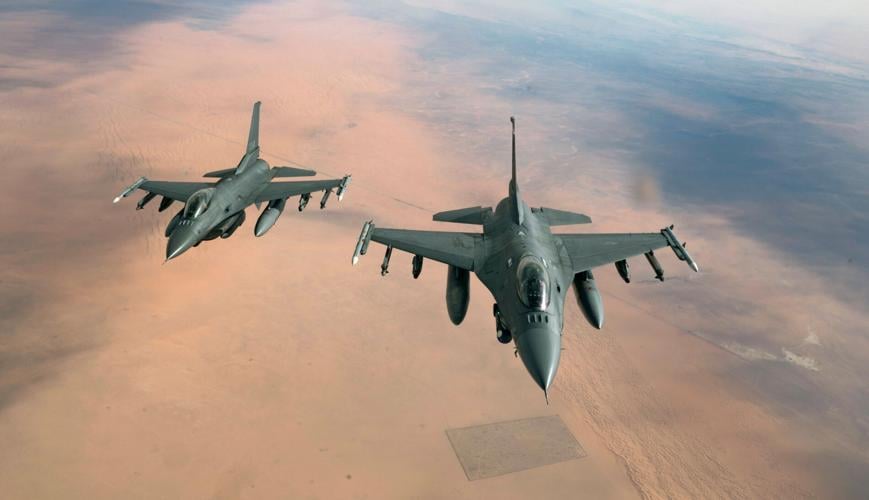The Air Force is denying access to records about plans for new low-level training flights above several large swaths of Arizona, including supersonic flights in some areas as low as 5,000 feet, a new lawsuit charges.
The Center for Biological Diversity’s lawsuit says the Tucson-based environmental organization began requesting various documents in December 2022 related to what is known as the Regional Special Use Airspace Optimization to Support Air Force Missions in Arizona. To date, said attorney Trisha Sharma, it has received no records nor an estimated date of completion for the request.
That’s important because of the impact the proposed changes will have, Sharma said.
“These deafening flights pose a serious threat to the people and animals who call these remote wildlands home,’’ she said. “Jets thundering overhead create health problems for people and harm imperiled animals, so it’s disappointing that the Air Force has gone radio silent in providing this crucial information.’’
The public lacks key information about the proposal, she said.

These are the military operation areas where the Air Force wants to expand flight training operations.
“The Air Force has been shockingly uncooperative every step of the way, even though the public has a right to this information,’’ Sharma said in a written statement. “Air Force officials should do the right thing and give people the info they need to understand what might happen to the places they live.’’
There was no immediate response from the Air Force.
The lawsuit says the plan is based on Air Force arguments it needs to address “training deficiencies associated with insufficient airspace.’’
To deal with that there are proposals to lower permitted flight attitudes, Sharma said.
In the Tombstone “military operation area,’’ for example, which spans an area along the border from Bisbee far into New Mexico, plans being considered would allow flights as low as 100 feet above ground level.
Also permitted would be supersonic operations at 5,000 feet. A typical commercial jet, operating subsonic, normally flies between 35,000 and 40,000 feet.
The plan also would allow release of flares and “chaff’’ — materials that include small pieces of metal or plastic designed to confuse radar — at 2,000 feet, versus the current 5,000-foot restriction.
And, at least under one option, the Tombstone military operation area would be expanded by nearly 800 square miles to 4,766 square miles.
Some other areas have smaller changes proposed, such as the 1,410 square mile area around Yarnell, Congress and Bagdad. There, flights could be 500 feet above ground, though there would be no change in current rules that allow supersonic operations at 10,000 feet. There would be a 2,000-foot restriction on flares and chaff.
In the 6,200-square-mile area that runs from Three Points and Arivaca through most of the Tohono O’odham Reservation, the biggest change appears to be to allow training flights from 6 a.m. through midnight; now the cutoff is 7 p.m.
And the military operation area from just east of Florence, through Miami, Safford and Clifton into New Mexico, would see supersonic authorization at 5,000 feet and regular flights at 500 feet in the 2,627 square mile area.
The Air Force, on its website describing the proposals, said that failing to make the changes would mean “training requirements would remain unmet’’ for pilots stationed at Davis-Monthan and Luke air force bases, as well as at the Morris Air National Guard Base next to Tucson International Airport.
On one hand, the Air Force said it isn’t creating any new military operation areas. But it says changes in how training can be conducted within them is necessary.
“Capacity of low-altitude and supersonic operations is needed to ensure pilots have the training they need for real-world environments,’’ the Air Force says.
“Because of limited capacity of the military operations areas, certain aspects of training are either curtailed, delayed or restructured to occur over several training events,’’ its report says. “This requires more time at a greater cost and results in reduced quality of training.’’
The lawsuit sees the changes through a different lens.
“The proposal seeks to authorize low-level fighter jet maneuvers and supersonic flights that would cause sonic booms above rural and tribal communities, important wilderness and conservation areas, and national monuments,’’ Sharma said in the lawsuit. “The proposal threatens to impact millions of acres of federal public land, increasing risk of wildfire and pollution and disrupting sensitive wildlife and ecosystems.’’
More immediate is the failure to respond, she said, to the request for information under the federal Freedom of Information Act.
“USAF’s failure to comply with FOIA harms the Center’s ability to provide full, accurate, and current information to the public on a matter of significant public interest,’’ Sharma said. “Without this information, the Center cannot advance its mission, with its members, to protect native species and their habitat.’’
The lawsuit asks U.S. District Court Judge Rosemary Marquez to order the Air Force to conduct a search “reasonably calculated’’ to locate all the records responsive to the request. It also seeks a cutoff date for getting the records.
No date has been set for a hearing.
The first A-10 jet was retired at Tucson's Davis-Monthan Base as part of a plan to retire all of the venerable planes in the next 3-5 years.






